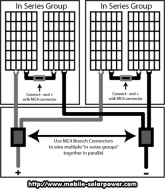awesome!
I would locate this as close to the battery as possible if this is to be your main battery fuse. All current flowing in/out of the battery should flow through it. I would personally size the wire to handle at least ~220A, which I think might translate roughly to > 1/0 AWG but I encourage you to reference a wire size calculator or ampacity chart (screenshots in my profile) and adjust to your conditions (important variables include insulation temperature of the wire, ambient temperature, whether the wire is bundled or in conduit, and wire length). If all that sounds too complicated, err on the safe side, just choose 105*C rated marine wire of 1/0 or larger and keep your wire run short and you will be good to go.
Lots of alternatives, just depends what you are looking for. Battleborn are expensive but they are a good product from a good reputable company with a good warranty. If I was going to buy drop-in lithium batteries I would strongly consider Battleborn, especially if I wanted something consumer friendly with a minimal learning curve.
The cheapest option is to build your own using raw cells from aliexpress or alibaba ('grey market cells') there is a much steeper learning curve and more risk and responsibility with this route, but considerable cost savings per kWh.
Middle ground options include:
- sourcing used Valence batteries (drop-in replacements),
- buying a cheaper drop-in replacement alternative to battleborn, I don't have a brand to recommend but there are many options including the costco deal. Personally I would be semi wary of a company you may come across called SOK, I have no reason to believe they sell a bad product in fact they might sell a very solid product, but they are a very new company and there appears to be a lot of astroturfing / manufacturing of interest going on with them right now.
- buying higher quality grade A (non-grey market) raw cells from the manufacturer or a distributor and building your own battery (same responsibility and learning curve as the grey market option, but more uniformerly high quality and less risk--though still some).
In your case, I think it may be a good decision to stick with BattleBorn or a similar option (maybe the Costco deal) unless you want to take on an additional DIY project / learning adventure in which case the raw cell route is an option. I encourage you to do your own research.
From everything I've read the Samlex Evo is an exceptional inverter that should serve you well for years, the manual is great (I reference it all the time and I don't even have a Samlex Inverter) and tech support is supposedly very helpful and knowledgeable. I think you made a good choice.
The Evo also gives you the option to pass the Solar Charge Controller through which opens up some additional functionality that may or may not be useful for you. And the second AC input for a generator is very useful in some use cases.
I purDzi, I pulled the trigger on an inverter charger, Samlex EVO-2224 2200W Pure Sine Inverter/Charger, Samlex EVO-RC Remote Control, and 175A Class T Fuse Kit from Don Rowe. They matched the Anchor Express price for the inverter charger and remote control. The solar panels are coming, the book is coming, and the stuff from Don Rowe will be here next Friday (from Oregon). Not really sure where the 175A fuse kit should go; maybe between the batteries and the inverter. Do you see any alternatives to the Battleborn batteries? Was going to buy two and put them in series to make 24 volts. Thanks for helping with the diagram and advice. This EVO-2224 has adjustable LVD, warning, and reset so it looks to be okay. Opinions?
Dzi, I pulled the trigger on an inverter charger, Samlex EVO-2224 2200W Pure Sine Inverter/Charger, Samlex EVO-RC Remote Control, and 175A Class T Fuse Kit from Don Rowe. They matched the Anchor Express price for the inverter charger and remote control. The solar panels are coming, the book is coming, and the stuff from Don Rowe will be here next Friday (from Oregon). Not really sure where the 175A fuse kit should go; maybe between the batteries and the inverter. Do you see any alternatives to the Battleborn batteries? Was going to buy two and put them in series to make 24 volts. Thanks for helping with the diagram and advice. This EVO-2224 has adjustable LVD, warning, and reset so it looks to be okay. Opinions?
I purchased this same unit at the start of August. I LOVE it!Dzi, I pulled the trigger on an inverter charger, Samlex EVO-2224 2200W Pure Sine Inverter/Charger, Samlex EVO-RC Remote Control, and 175A Class T Fuse Kit from Don Rowe. They matched the Anchor Express price for the inverter charger and remote control. The solar panels are coming, the book is coming, and the stuff from Don Rowe will be here next Friday (from Oregon). Not really sure where the 175A fuse kit should go; maybe between the batteries and the inverter. Do you see any alternatives to the Battleborn batteries? Was going to buy two and put them in series to make 24 volts. Thanks for helping with the diagram and advice. This EVO-2224 has adjustable LVD, warning, and reset so it looks to be okay. Opinions?
I was at the camp for the first two weeks so i could monitor how it worked and it's limitations. No Solar panels. Just the generator to charge my 4x12V series/parralel AGM battery bank (24V 165Ah).
First thing... firmware and manual for EVO2224 and RC needed an update. Still worked without it but new features/ setting options available with the updates. I Sent an e-mail to Samlex and within a few hours i received the necessary files and instructions! Great customer service!
Second, when i fired up the keurig (approx 1400W for 3-5mins), if my batteries were near 25V State of Charge, the draw for the Keurig would cause the Voltage to drop in the high 23.xxV. This would trigger my alarm and eventually cut off the inverter. To alleviate this, i fired up the genny first thing in the AM to run the Keurig and bring my Batteries full charge for the day. I run a small bar fridge... probably not the most efficient but it works!?
With the new firmware, I was able to select a profile to charge my batteries more efficiently. Otherwise, it would stay in absorption stage 10times the amount of time it was in Bulk... before i changed this, it would remain in absorption for many hours before reaching float and shutting down the generator.
Fast fwd to Sept 20th... i installed 2x320W Solar panels with a Victron MPPT 100V 30A Bluetooth charge controller. (LOVING IT!!) Each day, sunny or not, my batteries reach full charge. On less sunny days, charging remains in bulk stage longer but on a good day i can be in float before noon?
I changed the alarm settings to 23.5V and low voltage to 23V. Now when fire up the keurig first thing in the morning at around 25V, the draw doesn't cause the Voltage to drop below that treshold and the alarm doesn't trigger.









